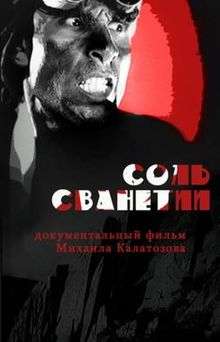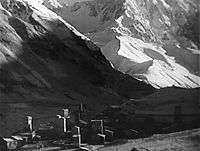Salt for Svanetia
| Salt for Svanetia | |
|---|---|
 | |
| Directed by | Mikhail Kalatozov |
| Written by |
Sergei Tretyakov Mikhail Kalatozov |
| Cinematography |
Shalva Gegelashvili Mikhail Kalatozov |
| Edited by | Viktor Shklovsky[1] |
| Distributed by | Gruziya-film[2] |
Release dates | Produced in 1930, Premiere in November 1931[2] |
Running time | 55 min |
| Country | Georgian SSR, Soviet Union |
| Language | Silent film |
Salt for Svanetia (Georgian: მარილი სვანეთს, Russian: Соль Сванетии) is a 1930 Georgian silent documentary film directed by Mikhail Kalatozov. As one of the earliest ethnographic films, it documents the life of the Svan people in the isolated mountain village of Ushguli in Svanetia, in the northwestern part of the Georgian Soviet Republic. Containing some propaganda, the climax of the film shows how a Soviet built road connects the previously isolated mountain village to Soviet civilisation. Many of the scenes of the film were staged, and the authenticity of some scenes has been disputed by the Svan people.
Synopsis

Most of Salt for Svanetia describes and explores the daily life of the Svan people, who are living isolated from civilisation in a harsh natural environment in the mountainous region of Svanetia. The film starts with the Lenin quotation "Even now there are far reaches of the Soviet Union where the patriarchal way of life persists along with remnants of the clan system." Svanetia and the mountain village of Ushguli are then located on two slowly dissolving maps of the region and are described as "cut off from civilization by mountains and glaciers". The location of the village is further introduced by several expository shots showing the Svanetian landscape. These shots give some emphasis to tall towers (still visible in the 2006 photograph below). It explains that these have been constructed by villagers to serve as a defense against feudal overseers, and it shows how villagers have used them to fend off tax collectors by heaving rocks from the tower tops. This introductory focus on class conflict fades as the film moves to concentrate on the daily routine of the villagers. One sequence shows how sheep are raised, another how wool and yarn are produced, and another on how barley is threshed. These sequences powerfully convey the technological underdevelopment of the area. Wool spinning technique antedates the spinning wheel; barley is threshed by cattle dragging a stone studded platform, weighed down by a mother tending to her child, over the barley. Another scene shows a suspension bridge and a man trying to cross over rushing water as his pack animals resist. A desperate harvest during an early July snowstorm is shown. Other scenes show how the Svan people tailor their clothes, make hats, cut their hair and bury their dead.
The film then concentrates on the lack of salt supplies. Cut off from the outside world for most of the year, the village suffers from a shortage of salt. It is shown how this forces the animals to lick human sweat and urine. A party of workers, returning from migratory labor farther down the valley, are shown bringing salt back to the village. Most of them die when they are crushed by an avalanche. The solution to the salt shortage is presented in the climax of the film where the young Soviet power builds a road that connects the isolated region to the outside world. The film shows how teams of construction workers with their steamrollers arrive, cutting down a forest that is the last obstacle for the road that will connect the Svan people with Soviet civilisation.
Production
Svanetia was an underdeveloped region, and thus Soviet planners tried to make it a showcase of Soviet modernization during the First Five-Year Plan between 1928 and 1932. During this time roads were built, an air service was established and industries such as mining and lumbering were developed. At the same time Soviet authorities tried to change and sovietize the traditional life of the Svan people. It was against this background of Svanetia as a showcase of Soviet modernization that Salt for Svanetia was produced.[3]
Inspired by a tour of the Caucasus, the writer and journalist Sergei Tretyakov wrote a newspaper article that gave Kalatozov the idea for the film. Tretyakov then wrote a script for Kalatozov, and shooting began in the mountain village Ushguli in Upper Svanetia.[4] Originally the film was planned to be a fictional feature film, but ultimately Viktor Shklovsky edited the footage Kalatozov had shot in Svanetia into a documentary film.[1] Most, but not all, parts of the documentary were staged, similar to other Soviet documentaries of the early 1930s.[5] The authencity of some scenes has been disputed by the Svan people who deny that some of the customs shown have ever existed.[6] The cinematography of Mikhail Kalatozov and the cinematographer Shalva Gegelashvili has been described as expressionistic due to its use of dramatic shadows, silhouettes against a dramatic skyline and Dutch angles.[5]
Responses
After the film was finished it was criticized by Stalinist authorities as being unbalanced and unfair towards Svanetia. It was claimed that the director was too fascinated by the backwardness and superstition of Svanetia, and only superficially interested in socialist modernization. Kalatozov fell out of favor, culminating in a ban of his next film Nail in the Boot and a denunciation of his script on Imam Shamil.[7][8]
Despite the negative immediate reaction, Salt for Svanetia has been praised by film historians and other film directors. The Russian film director Andrei Tarkovsky called it an "amazing film".[9] The American film historian Jay Leyda described it as a "masterpiece" and "the most powerful documentary film I have ever seen".[10]
Related
In 2015 the Scottish klezmer band Moishe's Bagel created a CD soundtrack with the same name to accompany the film. [11]
References
- 1 2 Lary, Nikita (February 1998). Nicholas Rzhevsky, ed. The Cambridge Companion to modern Russian culture. Cambridge University Press. p. 314. ISBN 978-0-521-47799-4.
- 1 2 Rollberg, Peter (November 2008). Historical Dictionary of Russian and Soviet Cinema. Scarecrow Press. p. 598. ISBN 978-0-8108-6072-8.
- ↑ Olson, James Stuart; Lee Brigance Pappas; Nicholas Charles Pappas (March 1994). An Ethnohistorical dictionary of the Russian and Soviet empires. Greenwood Publishing Group. p. 606. ISBN 978-0-313-27497-8.
- ↑ Sargeant, Amy (May 2008). Storm Over Asia: Kinofile Filmmakers' Companion 11. I.B. Tauris. p. 13. ISBN 978-1-84511-374-2.
- 1 2 Roberts, Graham (April 1999). Forward Soviet!: History and Non-Fiction Film in the USSR. I. B. Tauris. pp. 114–115. ISBN 978-1-86064-282-1.
- ↑ Hockings, Paul (September 1995). Principles of visual anthropology. Walter de Gruyter. p. 24. ISBN 978-3-11-012627-3.
- ↑ Barnouw, Erik (January 1993). Documentary: a history of the non-fiction film. Oxford University Press. p. 69. ISBN 978-0-19-507898-5.
- ↑ Woll, Josephine (September 2003). The Cranes Are Flying: The Film Companion (KINOfile). I. B. Tauris. pp. 22–23. ISBN 978-1-86064-504-4.
- ↑ Ishimov, V.; R. Shejko (September 2006). "The Twentieth Century and the Artist". In John Gianvito. Andrei Tarkovsky: interviews. University Press of Mississippi. p. 136. ISBN 978-1-57806-220-1.
- ↑ Christie, Ian; Richard Taylor (June 1993). Eisenstein Rediscovered: Soviet Cinema of the '20s and '30s. Routledge. p. 120. ISBN 978-0-415-04950-4.
- ↑ "Moishe's Bagel - Salt For Svanetia at propermusic.com". Propermusic.com. Retrieved 2015-12-18.
External links
- Salt for Svanetia at the Internet Movie Database
- Salt for Svanetia on YouTube (English subtitles)